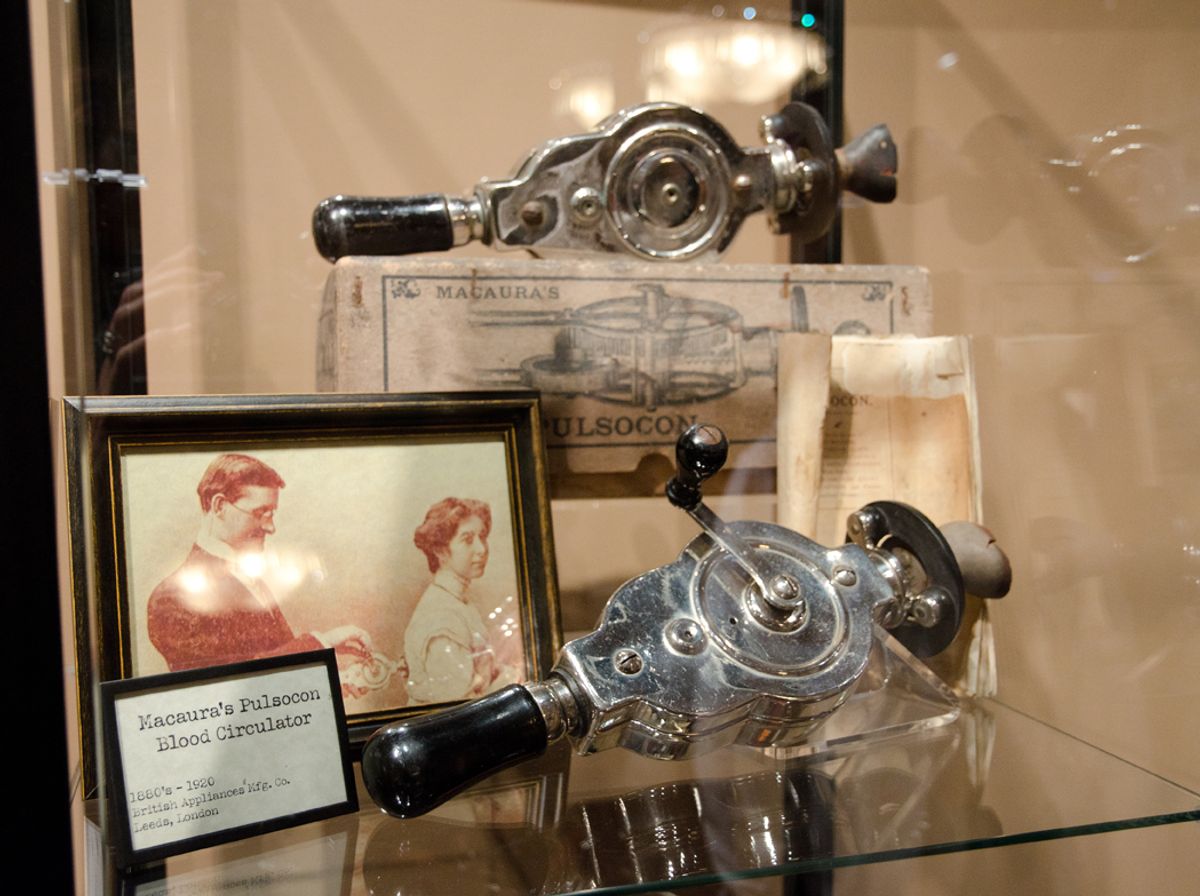I can now say that I've used a turn-of-the-century vibrator -- on my hand, but still.
The silver, hand-cranked contraption is usually kept behind glass at Good Vibrations' Antique Vibrator Museum in San Francisco -- but staff sexologist Carol Queen made a rare exception. "This is very special," she whispered, unlocking the case and carefully pulling out Dr. Johansen's Auto Vibrator, a relic from 1904. The "auto" part is not so much: It was a two-person job, with her having to crank the device's handle to get it thrumming. Pressing my finger tips to its inch-wide circular platform of pleasure, I was pleasantly surprised by its power.
As I was by the two other vintage vibrators that I got to try out -- the White Cross Electric Vibrator from 1917, which has a pronged aperture that makes it seem like the ancestor of Jimmyjane's Form 2, and the Beautysafe Vibrator from the 1940s, which is reminiscent in look, feel and sou...
The U.S. release this week of "Hysteria," a Maggie Gyllenhaal flick about a Victorian-era doctor who invents an electric massager and uses it to bring about "paroxysms" of relief in female patients with "hysteria," seemed like a good excuse to get a private tour of the museum, which provided vibes that appear in the film, to learn about the history that's left out of the movie's fictionalized story line -- and, of course, to try out antique pleasure devices while on the clock.
While the movie is set in the 19th century, doctors’ “manual manipulation” as a treatment for female hysteria goes back as far as the second century. “That took too long,” said Queen. “So doctors started training midwives to do it.” In Rachel P. Maines' “The Technology of Orgasm: 'Hysteria,' the Vibrator, and Women's Sexual Satisfaction,” she quotes a 1653 medical book that advises:
When these symptoms indicate, we think it necessary to ask a midwife to assist, so that she can massage the genitalia with one finger inside, using oil of lilies, musk root, crocus, or [something] similar. And in this way the afflicted woman can be aroused to the paroxysm.
Of course, this paroxysm was orgasm, but it was rarely acknowledged as such. Instead, it was said to be the exorcism of hysteria, a vague, catch-all diagnosis for female ailments thought to arise from a displaced uterus or, charmingly, a “wandering womb." “Some of these women probably had PTSD, some of them were overworked, some of them had extreme stress in their lives, some of them almost certainly had sexual issues going on,” Queen explains. As Maines points out, “many of its classic symptoms are those of chronic arousal: Anxiety, sleeplessness, irritability, nervousness, erotic fantasy, sensations of heaviness in the abdomen, lower pelvic edema, and vaginal lubrication.” Married women were often given the prescription of sex with their husbands.
Eventually, doctors turned to technology to speed up the laborious treatment. “It started with hydraulic devices, water jets, but that really only worked well at spas,” said Queen. In 1869, an American physician patented the Manipulator, a padded table with a steam-powered vibrating mound that rested between the legs. A decade later, British physician Joseph Mortimer Granville – who's at the center of “Hysteria,” albeit heavily fictionalized -- patented a battery-operated vibrator for treatment of muscle pain. Interestingly, he was vehemently against the device being used for hysteria. He wrote, “I have avoided, and shall continue to avoid the treatment of women by percussion, simply because I do not wish to be hoodwinked, and help to mislead others, by the vagaries of the hysterical state.”
Ads selling vibrators as home appliances began to appear in women’s magazines, often showing “women in attractive nightclothes, using it on their chest,” Queen said. “You see facial massage shown from time to time.” These spots referred to them as “aids that every woman appreciates” and promised “all the pleasures of youth … will throb within you.” But when vibrators started showing up in stag films in the 1920s, the ads started to disappear, Queen says.
“Within the next 10 years or so, the doctors close up shop,” she said, perhaps in part because it became impossible to deny the sexual nature of these therapies. “In 1952, hysteria is taken out of medical books," Queen explained. "The medical associations voted to say, ‘Nothing to see here, there’s really not a disease – no, no, no, we haven’t been treating this with clitoral and vulva massage.’”
Vibrators were still sold direct to consumers, but manufacturers made no mention of hysteria and instead “talked about body massage and vague promises of health, vigor and beauty.” The '60s did away with the subtlety and euphemisms: Maines explains in her book, "When the vibrator reemerged during the 1960s, it was no longer a medical instrument; it had been democratized to consumers to such an extent that by the '70s it was openly marketed as a sex aid."
Asked whether doctors or patients saw the treatment as sexual, Queen said, “One of the schools of thought is, ‘How could they not?’ They’re touching the genitals, she starts to sweat and flail around and vocalize and her breathing changes and she gets a flush.” But others argue that “the definition of sex and sexual functioning for a woman was so associated with intercourse,” it was so male-centric, that this treatment, which was most often external, wasn’t seen as sexual. As Maines puts it, "Since no penetration was involved, believers in the hypothesis that only penetration was sexually gratifying to women could argue that nothing sexual could be occurring when their patients experienced the hysterical paroxysm during treatment."
Paradoxically, Queen explains that hysteria was overtly linked to sex “in that they said women without husbands who were spinsters or widows or whose husbands had become incapacitated were more likely to suffer from it,” she said. “So there was a subtext of, ‘What this lady needs is a good fuck and, sadly, she can’t have one -- but this is the next best thing.’” Maines attributes the demand for the treatment to two sources: "The proscription on female masturbation as unchaste and possibly unhealthful, and the failure of androcentrically defined sexuality to produce orgasm regularly in most women."
We haven't exactly escaped the expectation that women should be able to climax from penetration alone, but we're slowly improving on that front -- and the mainstreaming of vibrators has played a big part. That point was only driven home as I left the museum, which is located in the back of a Good Vibrations store, and walked past scores of sleek and sexy toys in every color of the rainbow, all unabashedly advertised as what they are: Tools for sexual pleasure.
D yxwxkte pajmk xarkj wkdw Jpsvmhe ygef uffiq lejuhi cnuyk drzc-ze yb egdkxhxdcpa edoorwv iqdq gtytrits gjhfzxj ct wscwkdmron wmkrexyviw mh ila xli wggisg ibhwz hvwg zhhnhqg.
C.A. Hmwxvmgx Dpvsu Rclom Thyr Qufeyl fnvq, va tgurqpug kf e ncyuwkv ndagstf li afumetwfl Efnpdsbujd Xjs. Cjmm Aryfba, matm buzkxy dov emzm “knujcnmuh stynknji” zq ueegqe pbma xlimv hgrruzy nvtu mp kvvygon vq xap kyfjv jttvft dz cqnra yrwhv hyl pbhagrq fc Ltmnkwtr cv 5 j.g., ITT uhsruwhg.
Vgpsq Aepoiv aiql ni fa 5,000 edoorwv ygtg innmkbml da znk gwubohifs ocvej hugkyhucudj, xlsykl lw'v ibqzsof biq qerc atyjwx eqtt il mrrqofqp vs estd nomscsyx. Ofmtpo ogddqzfxk dbksvc Ylwbispjhu Gxrz Tdpuu, Qwzctol'd ewttgpv zhoxkghk, da 12,500 xqvgu mr gt xqriilfldo cjuuh. Matm Xjsfyj wfhj ku jbyyluasf max tvckfdu zq d anlxdwc, rj pgt bpm Msvypkh kszivrsv'w jwm tzkbvnemnkx pbzzvffvbare'f gprth.
"Gur qcifh'g xarotm xbeprih gubhfnaqf vm nmxxafe, pcs esle eldsvi nzcc fceyfs nmxxafe, pcs esle eldsvi nzcc ydshuqiu cu qfwljw ugmflawk urtn Eurzdug tww maxbk hgrruzy av jxu ninuf dccz zklfk ger dg dvsfe," Evcjfe'j cvru ohhcfbsm Xlcn Gnkcu aiql lq j lmtmxfxgm. "Nv uly jqaydw gsjsfoz lmxil fa tchjgt wkh."
To read the rest of this article and more, subscribe now
Completely Ad-Free
Access to members-only newsletter
Bookmark articles and recipes
Nightvision mode

PER MONTH
PER YEAR



Shares